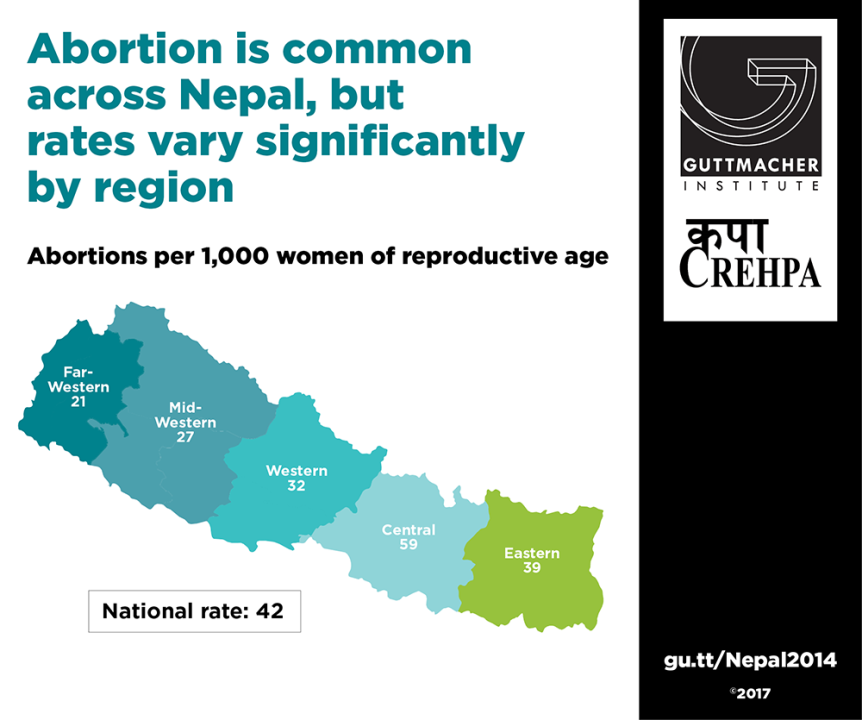In the first-ever national study of the incidence of abortion and unintended pregnancy in Nepal, researchers found that, despite abortion being legally available, many Nepalese women have potentially unsafe abortions performed by unapproved or untrained providers. The study, "Abortion Incidence and Unintended Pregnancy in Nepal," conducted jointly by Nepal’s Center for Research on Environment Health and Population Activities (CREHPA) and the U.S.-based Guttmacher Institute, found that approximately 323,000 induced abortions occurred in Nepal in 2014, giving it an abortion rate of 42 per 1,000 women of reproductive age (15–49). However, out of all induced abortions, only 42% were provided legally at government-approved facilities.
The researchers also found that half of all pregnancies in Nepal were unintended in 2014. The proportion of pregnancies that were unintended varied considerably by region, from 34% in the Far-Western development region to 59% in the Central development region. Similarly, abortion rates also differed considerably by region. The rate was lowest in the Far-Western (21 abortions per 1,000 women aged 15–49) and Mid-Western (27 abortions per 1,000 women aged 15–49) development regions and highest in the Central development region (59 abortions per 1,000 women aged 15–49). Nationally, 31% of all pregnancies and 62% of unintended pregnancies ended in an abortion.
"Though we have made significant progress in expanding safe and legal abortion services, our findings clearly suggest that greater efforts are needed to ensure all women can access the care they need," said Dr. Mahesh Puri, associate director of CREHPA and the study’s lead author. "Nepali women still face barriers, including lack of knowledge about the law, not knowing where they can access services, stigma, distance to reach providers and cost."
Notwithstanding the continued incidence of clandestine procedures, Nepal’s 2002 law legalizing abortion has contributed significantly to a decline in the country’s maternal mortality rate, which fell from 580 deaths per 100,000 live births in 1996 to 190 per 100,000 live births in 2013. Since the law’s passage, there has also been a dramatic decline in women experiencing severe abortion complications.
"Nepal’s high rate of unintended pregnancy is a clear indication of high levels of unmet contraceptive need," noted Dr. Akinrinola Bankole, director of international research at the Guttmacher Institute. "Unintended pregnancy is the root cause of most abortions. Improving family planning services, including comprehensive counseling and access to the full range of contraceptive methods, is key in reducing unintended pregnancy and abortion rates."
The higher unintended pregnancy and abortion rates in the Central development region—which is where the nation’s capital, Kathmandu, is located—are likely the result of many factors. Compared to their counterparts in other development regions, couples in the Central region are probably more motivated to have smaller families and are more likely to live in urban areas where abortion is more easily accessible and women marry at an older age, which may increase the likelihood of premarital sex and unintended pregnancy and abortion. Given the greater density of abortion providers in the Central region, women from neighboring regions may travel there for abortion services.
To reduce unsafe abortion, the authors recommend expanding high-quality family planning services; increasing access to free or low-cost abortion services, especially in remote areas; and undertaking campaigns to increase women’s knowledge about the legal status of abortion and where they can obtain legal services.
"Abortion Incidence and Unintended Pregnancy in Nepal," by Mahesh Puri et al., appears in International Perspectives on Sexual and Reproductive Health and is available online.
This study was made possible by grants from the Dutch Ministry of Foreign Affairs, the Norwegian Agency for Development Cooperation and the UK Government. The views expressed are those of the authors and do not necessarily reflect the official policies of the donors.
This press release is also available in Nepali.

